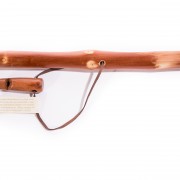When it comes to walking staffs, always look for wooden hiking sticks. There are a few major reasons why wood trekking poles are far superior to any other type. I’ll begin with one of the most important reasons. They naturally decompose! I know people don’t intend to destroy the environment, but non-organic materials don’t do our planet any favors. A lot of canes are made from fiberglass, metals, or plastics. At best, these types have to end up in landfills when they are broken or no longer wanted, at worst, they end up in our beautiful hiking trails.
One of the most common mistakes is simple forgetfulness, nothing malicious, but can still be damaging to the environment. Have you ever misplaced or forgot your hiking stick? I know I have. Most of the time I remember and I’m able to just hoof it backwards and pick it up, but there have been times when I have my tent all setup and my sleeping bag rolled out when it dawns on me that I left my hiking and I’m now 20 miles further up a mountain. OOPS! Thank fully I’ve always used one of my wood sticks.

A lot of wood hiking sticks come with a rubber tip because that has become the new norm in the industry. If you have the option, ask your artist to finish the piece of with a simple rounded bottom and no rubber. One less piece of potential litter created and one less piece of rubber that needs to be made in a factory.
I have an interesting story of another use for a wood hiking stick.
We were on a five day hike up the Andes Mountains when we started approaching our campsite. One of the people on our hike had already been to this campsite and mentioned that we need to keep an eye on our hiking staffs. We smiled and thought he was joking because we’re 12000 feet in the mountains and nobody else was around us to steal them.
We got our dinner ready and then noticed the person who maintains the campsite was putting together a bon fire. After we cleaned up, we headed over to hang out by the fire. A few minutes passed and my buddy noticed one of the pieces of burning wood looked a lot like his hiking stick. We both looked closer and to our surprise; all of the hiking sticks were on fire. Stunned, we thought about pulling them out, but noticed they had been broken into pieces.
Burning didn’t even cross our mind when it was mentioned to keep an eye on the trekking sticks.
Later we thought about the situations and it actually made sense to us. They can burn. That thought can sound incredibly simple, but really think about the aspects involved. We were hiking in the rainy season, so most timber that can be gathered is going to be water logged. Our sticks had been perfectly dried when they were being made. And they were free to the person who lives there. Sounds like perfect tinder wood when they’re broken into pieces.
Live and Learn.
Cheers,
-Antonio






